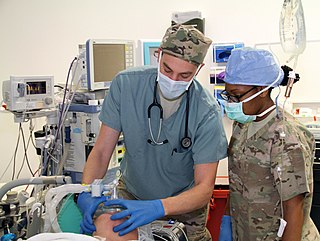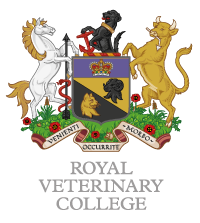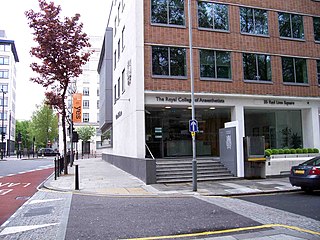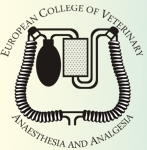This article needs additional citations for verification .(July 2017) |
The Association of Veterinary Anaesthetists (AVA) are a group of people who promote the usage, research, and study of anaesthesia in veterinary medicine.
This article needs additional citations for verification .(July 2017) |
The Association of Veterinary Anaesthetists (AVA) are a group of people who promote the usage, research, and study of anaesthesia in veterinary medicine.
The Association was established in 1964, [1] and they meet regularly in Europe to discuss various issues related to their cause. It has its administrative base on Hawkshead Lane in North Mymms, Hertfordshire, at the (main) Hawkshead Campus of the Royal Veterinary College. On April 26, 1993, the European College of Veterinary Anaesthesia and Analgesia (ECVAA) was formed to regulate qualifications in veterinary anaesthesia in Europe and is a member of the European Board of Veterinary Specialisation.
The AVA gives out scholarships and also provides training and education in the area of Veterinary Anaesthetists. A trust fund was established in the early 1970s and each year they give out grants to trainees studying for both RCVS and ECVAA Certificates and Diplomas in veterinary anaesthesia.
The AVA publishes the journal Veterinary Anaesthesia and Analgesia six times a year, which is also the official journal of the European College of Veterinary Anaesthesia and Analgesia and the American College of Veterinary Anesthesia and Analgesia.[ citation needed ]

Anesthesiology, anaesthesiology, or anaesthesia is the medical specialty concerned with the total perioperative care of patients before, during and after surgery. It encompasses anesthesia, intensive care medicine, critical emergency medicine, and pain medicine. A physician specialized in anesthesiology is called an anesthesiologist or anaesthetist, depending on the country.

The Royal Veterinary College is a veterinary school located in London and a constituent college of the federal University of London. The RVC was founded in 1791 and joined the University of London in 1949. It is the oldest and largest Veterinary school in the United Kingdom, and one of only nine in the country where students can study to become a vet.

The Association of Anaesthetists, in full the Association of Anaesthetists of Great Britain and Ireland (AAGBI), is a professional association for anaesthetists in the United Kingdom and Ireland.
A veterinary specialist is a veterinarian who specializes in a clinical field of veterinary medicine.
Thomas Cecil Gray CBE KCSG was a pioneering English anaesthetist.

The Royal College of Anaesthetists (RCoA) is the professional body responsible for the specialty of anaesthesia throughout the United Kingdom. It sets standards in anaesthesia, critical care, pain management, and for the training of anaesthetists, physicians' assistants (anaesthesia), and practising critical care physicians. It also holds examinations for anaesthetists in training, publishes the British Journal of Anaesthesia, and informs and educates the public about anaesthesia. Its headquarters is in Churchill House, London.
John Wharry Dundee OBE, was an anaesthetist and prolific medical researcher from Ballyclare, County Antrim, Northern Ireland.

Methoxyflurane, sold under the brand name Penthrox among others, is an inhaled medication primarily used to reduce pain following trauma. It may also be used for short episodes of pain as a result of medical procedures. Onset of pain relief is rapid and of a short duration. Use is only recommended with direct medical supervision.
Andrew Gerald Doughty MRCS LRCP FRCA FRCOG was an English anaesthetist.
Veterinary anesthesia is anesthesia performed on non-human animals by a veterinarian or a Registered Veterinary Technician. Anesthesia is used for a wider range of circumstances in animals than in people, due to animals' inability to cooperate with certain diagnostic or therapeutic procedures. Veterinary anesthesia includes anesthesia of the major species: dogs, cats, horses, cattle, sheep, goats, and pigs, as well as all other animals requiring veterinary care such as birds, pocket pets, and wildlife.

Alfaxalone, also known as alphaxalone or alphaxolone and sold under the brand name Alfaxan, is a neuroactive steroid and general anesthetic which is used currently in veterinary practice as an induction agent for anesthesia and as an injectable anesthetic. Though it is more expensive than other induction agents, it often preferred due to the lack of depressive effects on the cardiovascular system. The most common side effect seen in current veterinary practice is respiratory depression when Alfaxan is administered concurrently with other sedative and anesthetic drugs; when premedications aren't given, veterinary patients also become agitated and hypersensitive when waking up.

The British Journal of Anaesthesia is a monthly peer-reviewed medical journal published by Elsevier on behalf of the Royal College of Anaesthetists, the College of Anaesthesiologists of Ireland, and the Hong Kong College of Anaesthesiologists, for all of which it serves as their official journal.

The Australian Society of Anaesthetists is an association that seeks to further the best interests of anaesthesia and anaesthetists.

Paraveterinary worker is the professional of veterinary science that performs procedures autonomously or semi autonomously, as part of a veterinary assistance system. The job role varies throughout the world, and common titles include veterinary nurse, veterinary technician and veterinary assistant, and variants with the prefix of 'animal health'.
The following outline is provided as an overview of and topical guide to anesthesia:

The European College of Veterinary Anaesthesia and Analgesia (ECVAA) is one of 25 veterinary specialist colleges recognized by the European Board of Veterinary Specialisation, comprising more than 35 distinct specialties.
The World Federation of Societies of Anaesthesiologists (WFSA) is an international federation of independent national professional associations of anaesthesiologists. The WFSA’s Secretariat is based in London, UK.

John Gillies, was a Scottish anaesthetist, who worked at the Royal Infirmary of Edinburgh (RIE). For gallantry as a serving soldier in WWI he was awarded the Military Cross. He founded the department of anaesthetics in the RIE and became its first director. The Gillies anaesthetic machine which he devised was the first British closed circuit anaesthetic device and was in use until the 1960s. With his colleague HWC ('Griff') Griffiths he pioneered the technique of high spinal anaesthesia to produce hypotension and 'bloodless' operating fields. Gillies anaesthetised King George VI in Buckingham Palace and was made Commander of the Royal Victorian Order (CVO) for this service. He was president of the Association of Anaesthetists of Great Britain and Ireland from 1947 to 1950.

Peter John Firth Baskett (1934–2008) was a Northern Irish physician, specializing in anaesthesia. He was responsible for the introduction of paramedics into the United Kingdom, created specialist ambulances for delivering on-scene pain relief to patients, and was the first chairman of the European Resuscitation Council.
The American College of Veterinary Anesthesia and Analgesia (ACVAA) is one of the veterinary specialist colleges recognized by the American Veterinary Medical Association.